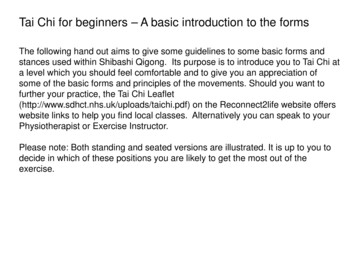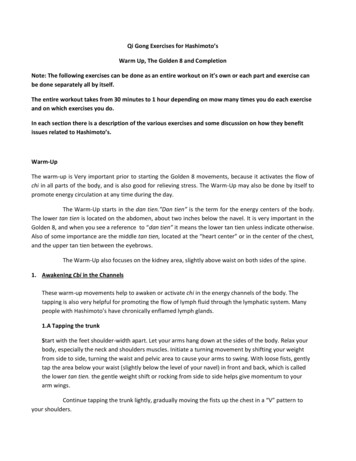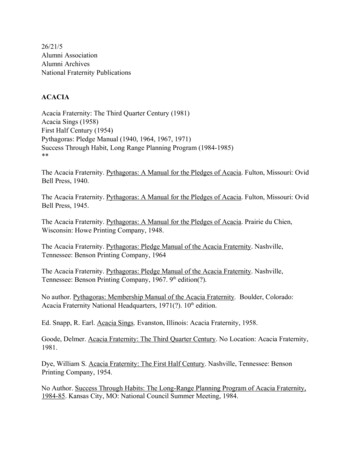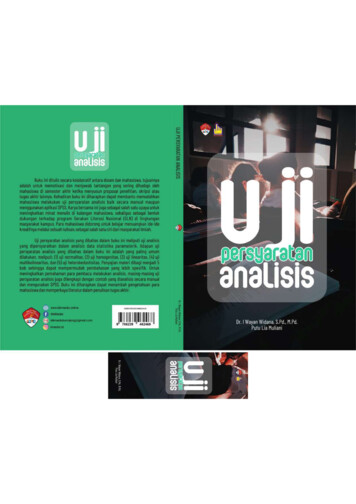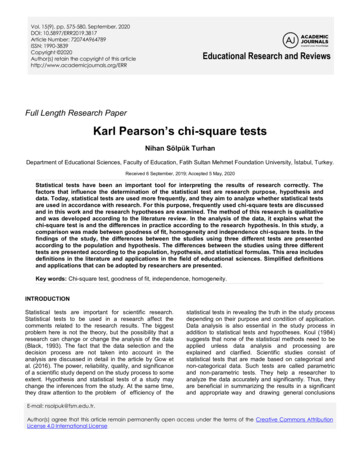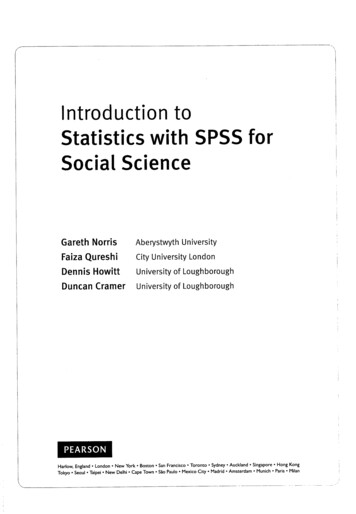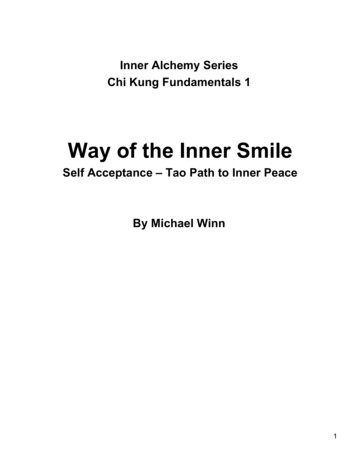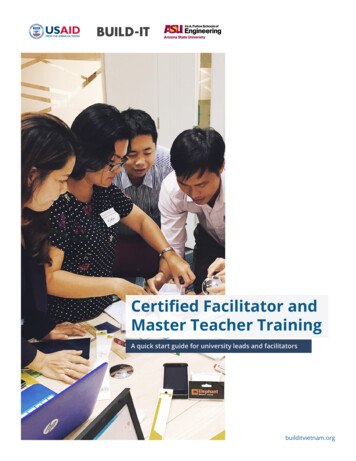![[T] Effects Of Ai Chi And Yamamoto New Scalp Acupuncture On Chronic Low .](/img/60/camilotti-bm-et-al-2015-low-back-pain-and-ai-chi-2.jpg)
Transcription
ISSN 0103-5150Fisioter. Mov., Curitiba, v. 28, n. 4, p. 723-730, Oct./Dec. 2015Licenciado sob uma Licença Creative CommonsDOI: ]Effects of Ai Chi and Yamamoto new scalpacupuncture on chronic low back pain[I]Efeitos do Ai Chi e da cranioacupuntura deYamamoto na dor lombar crônica[A]Bárbara Maria Camilotti[a], Neiva Leite[a], Daysi Alberti[a], Inara Aparecida Francisco[b],Vera Lúcia Israel[a]*[a][b]Universidade Federal Do Paraná (UFPR), Curitiba, PR, BrazilPontifícia Universidade Católica do Paraná (PUCPR), Curitiba, PR, Brazil[R]AbstractIntroduction: Low Back pain affects a large part of the population and represents a major socioeconomicproblem. There are many resources for treatment of this symptom, among them: acupuncture and aquatictherapy. Objective: To compare the effects of an aquatic physical therapy program (AI CHI) and YamamotoNew Scalp Acupuncture (YNSA) in pain intensity and functionality in patients with chronic low back pain.Material and methods: a clinical trial with a randomized sample. Sixty six individuals with chronic lowback pain, of both genders were selected, however 44 individuals completed the study. The individuals weredivided into three groups AI CHI (n 15), YNSA (n 15) and Control (n 14). Ten 10 interventions with aprogram of aquatic therapy method (Ai Chi) and Yamamoto New Scalp Acupuncture (YNSA), were made,* BMC: PhD, e-mail: ba camilotti@hotmail.comNL: PhD, e-mail: neivaleite@gmail.comDA: MSc student, e-mail: daisyalberti@hotmail.comIAF: grad, e-mail: inara.francisco1111@gmail.comVLI: PhD, e-mail: vera.israel@gmail.comFisioter Mov. 2015 Oct/Dec;28(4):723-30
724Camilotti BM, Leite N, Alberti D, Francisco IA, Israel VL.twice a week. The control group received the intervention only after the end of the study. Pain intensitywas assessed by a visual analogue scale (VAS) and the functional capacity by Owestry functionality Index.Results: There was significant reduction in pain and improvement in functional capacity (p 0.05) in YNSAand AI CHI and when compared to the control group. Conclusion: It was concluded that the YNSA and AICHI were effective in reducing pain and improving the functionality of the lumbar spine in patients withchronic low back pain.[P]Keywords: Acupuncture. Aquatic therapy. Physiotherapy.[B]ResumoIntrodução: Lombalgias acometem grande parte da população e promovem grande impacto na sociedade.Existem diversos recursos para o tratamento deste sintoma dentre eles, a acupuntura e a fisioterapia aquática. Objetivo: comparar os efeitos de um programa atividade física aquática (AI CHI) e cranioacupuntura deYamamoto (YNSA) na intensidade da dor e funcionalidade em indivíduos com dor lombar crônica. Material emétodos: estudo clínico experimental com amostra randomizada. Foram selecionados 66 indivíduos com dorlombar crônica, de ambos os gêneros, entretanto completaram o estudo 44 indivíduos. Os indivíduos foram divididos em três grupos AI CHI (n 15), YNSA (n 15) e Controle (n 14). Foram realizados 10 atendimentos de umprograma de fisioterapia aquática, com o método Ai Chi e de cranioacupuntura de Yamamoto, com frequência de2 vezes por semana. O grupo controle recebeu intervenção somente após o término do estudo. A intensidade dador foi avaliada por uma escala visual analógica (EVA) e a capacidade funcional pelo Índice de funcionalidadede Owestry. Resultados: Observou-se redução significativa na dor e incremento na funcionalidade (p 0,05) nosgrupos Ai Chi e YNSA e em relação ao grupo controle. Conclusão: Pode-se concluir que o Ai Chi e a YNSA foramefetivos na redução da dor e melhora na funcionalidade da coluna lombar em indivíduos com dor lombar crônica.[K]Palavras-chave: Acupuntura. Hidroterapia. Fisioterapia.IntroductionLow back pain is very common and affects a largepart of the population (1, 2). In Brazil about 10 million people become disabled by low back pain (3).According to World Health Organization (4), morethan 80% of people around the world are affected bypain in the spine at some point in their lives and thelow back pain is the most common one.The low back pain can cause a large economicimpact, since most people with low back pain remainout of work or their productivity is reduced (5 - 9).Treatment costs are high and represents onus to patients and to government (5, 7, 10).A common resource used to treat low back pain isthe aquatic therapy also known as hydrotherapy, inwhich exercises are performed in a heated swimmingpool for therapeutic purposes (11). The AI CHI is aphysiotherapy method developed from the principalsof Tai Chi and Qigong methods associated with thetechniques of Shiatsu and Watsu methods. (12, 13). ItFisioter Mov. 2015 Oct/Dec;28(4):723-30is a treatment performed with the water at shoulderlevel and the movements of the arms, legs and trunkare slow and wide, they are associated to a deep andcalm breath. The benefits are associated to the stabilization of the trunk, pain control and improvementof the metabolism and blood flow (12).Another resource that can be applied to the treatment of low back pain is the acupuncture, in whichneedles are inserted at specific points on the skin (acupuncture points) in order to treat and prevent diseasesand reduction of the pain (14, 15, 16). The YamamotoNew Scalp Acupunture (YNSA) is one of the acupuncture techniques that can be used in the pain treatment.This technique was developed by Yamamoto and collaborators in the 70’s and consists of a microsystem,in which the stimulation or puncture of points in thescalp causes effects in another corporal region, contributing to the treatment of diseases, especially thepainful and neurological ones (17).The aquatic (18 - 22) and acupuncture therapy(23-27) have been used in treatment of low back pain.
Effects of Ai Chi and Yamamoto new scalp cupuncture on chronic low back painThe YNSA was effective in the treatment of acute lowback pain (28), until now there is no research of thelow back treatment with AI CHI technique or withthe combination of these two techniques.So, the objective of this research was to comparethe effects of an aquatic physical therapy program (AICHI) and YNSA in the intensity of pain and functionality in people with low back pain.Materials and methodsThis research was experimental, with sample randomization into 3 groups: AI CHI, YNSA and Control.The initial sample had 66 individuals, but in the AICHI group 4 people dropped out due to difficultiesto get to the study sit, 3 from respiratory pathologiesand 1 because the symptoms became worse. In theYNSA 5 participants dropped out due difficulties toget to the site and one was excluded for presentinguterine bleeding that is a contra-indication of thetechnique. In the control group 5 participants gaveup by difficulties to get to the site and 3 gave up without reason. So, the final sample had 15 participants inthe AI CHI, 15 in YNSA and 14 in the Control group.The research complied with CONEP resolution196/96 and the project was approved by the Ethicsand Research Committee of Hospital do Trabalhador,number 90.173, CAAE: 06511712.6.00005225. Allthe participants were informed of the procedure andsigned the consent term.The evaluations were done at the Centro deEstudos do Comportamento Motor (CECOM) at UFPRand the interventions were done at the HydrotherapyDepartment at the PUCPR in Curitiba-PR.Inclusion criteria were: both gender individualswith low back pain for at least 3 months, without evident postural alterations on the physical examination,age between 33 and 77 years, without pacemakeror metallic implant in the spine, without circulatoryor sensibility alterations, without lesion on the skin,without any previous physiotherapy treatment, acupuncture or massage 15 days prior the participationin the research and cognitive capacity preserved.Exclusion criteria were: radiation of the pain onthe legs, incapacity to participate in any stages of theresearch, pregnancy, dizziness, labyrinthitis, epilepsyand any other form of seizure.Temporary exclusion factors were considered,that is, if on the day of the participation the volunteerswere under the following conditions: blood pressuresover 150x90mmHg, and if they had alcoholic drinks48 hours prior to participation. If the volunteers submit this conditions they would not participate in theexperimental protocol and would be rescheduled andtreated in another.The evaluation instruments used were OswestryFunctional Index and Visual Analogue Scale (VAS).It was performed ten (10) interventions twice aweek. The control group participants received theinterventions after 5 weeks of the evaluation dateand received a similar protocol of the group that presented a better benefit.The acupuncture was done according to Yamamotoet al (17). The volunteers were in a seated positionand it was done a palpation of D point bilaterally. Theside in which the volunteer presented more painfulsensation or pressure was punctured. After that D1D5 point was punctured, in the same side of the Dpoint. The needles were maintained for 20 minutes.The AI CHI protocol was performed according toCunha et al (12).The interventions were made collectively in a swimming pool with temperature keptbetween 32 C e 34 C, during 30 minutes.The data regarding age, mass, height, BMI wereassessed using descriptive statistics (mean and standard deviation). The data pattern distribution of eachof these variables was analyzed using the Lillieforstest and the evaluating of the homogeneity of the variances between groups was done using the Levenetest. Once the assumptions of normality and homogeneity were checked, the means of the variables werecompared between groups by analysis of variance –one way factor followed by Fisher’s follow up test(Least Square Difference).The data regarding functionality (Oswestry) andthe pain scores (VAS) were analyzed by descriptivestatistics (mean and standard deviation), it was alsoassessed the assumptions of normality and homogeneity of the variances, as described above. Thenit was applied the analysis of variance to repeatedmeasures, and then the Fisher’s follow up test (LeastSquare Difference).ResultsThe final sample consisted of 44 volunteers diagnosed with chronic low back pain, that were selected from medical appointments at the Hospital doFisioter Mov. 2015 Oct/Dec;28(4):723-30725
726Camilotti BM, Leite N, Alberti D, Francisco IA, Israel VL.Trabalhador and from the hydrotherapy waiting listof the Unidade de saúde Ouvidor Pardinho. Table 1shows the physical characteristics of the participantsand the p 0.05 observed in all variables indicatesthat the groups are homogeneous.The visual analogic scale assesses pain in the exact moment of the evaluation. When performing theanalysis it was verified that there were significantdifferences between the groups over the intervention periods (p 0.05). It was found that the groupsstarted the study with the same pain scores (p 0.05).However, at the revaluation, the AI CHI and YNSAgroups showed reduction of the pain scores frombaseline evaluation. The control group showed nochange in their pain score (p 0.05) (Table 2).Regarding the functionality obtained by theOswestry Disability Index, the evaluation criteria refers to the best functionality as the scores reduces. Inthe present study we found that the subjects of thethree groups began with functionality statisticallysimilar (p 0,05). However, at the revaluation momentthe groups submitted to the interventions showed significant reduces in scores (p 0.05), except the controlgroup (p 0.05). Thus, the subjects submitted to theinterventions showed improvement in functionalityafter the intervention period (Table 3).Table 1- Mean and standard deviation of the variables age, mass, height and BMI of the groups AI CHI, YNSA and CON-TROL; p-value of the analysis of variance – one way factorAI CHIYNSAControl151514Age (years)61.7 9.357.3 7.261.2 7.20.251Mass (Kg)75.2 10.469.8 11.073.2 15.20.649Height (cm)164 9.6159 10.5159 9.40.375BMI (kg/m )27.8 3.427.6 3.628.7 4.30.868N2P valueTable 2 - Mean and standard deviation of pain intensity (VAS) for groups AI CHI, YNSA and CONTROL at evaluation andrevaluation periods; p value of variance analysis for repeated measuresAI CHINYNSA15Control15VAS initial6.6 2.4VAS final2.7 2.9*#6.9 2.8*14*0.9 1.9*#P value7.6 2.66.3 1.7#0.005Note: * means significant differences between evaluations (intra-groups) and # means significant differences between groups (inter-groups).Table 3 - Mean and standard deviation of Oswestry Disability Index for groups AI CHI, YNSA and CONTROL at evaluationand revaluation periods; p value of variance analysis for repeated measuresAI CHIYNSAControl151514Oswetry initial37.97 18.32*36.03 13.32*Oswestry final28.27 19.18Np value*#17.4 9.3*#43,14 14.0442,64 14.58#0.007Note: * means significant differences between evaluations (intra-groups) and # means significant differences between groups (inter-groups).Fisioter Mov. 2015 Oct/Dec;28(4):723-30
Effects of Ai Chi and Yamamoto new scalp cupuncture on chronic low back painDiscussionLow back pain is one of the major causes of disability, it interferes in quality of life, work productivity and it is the most common cause to medicalconsultation (30, 31). The clinical recommendationsfor low back pain treatment, done according to systematic review of literature, includes interdisciplinary rehabilitation, exercises (including aquatics), acupuncture, massage, manipulation, yoga and patientreeducation (32, 33).The aquatic exercises have shown positive resultsin low back pain symptoms (34). Researches showreduction in pain (18-22) and increment in functionality (35, 36) in treatments done in aquatic environment; these findings confirm the results observed inthe present study. However, it should be noted thatit was not found, until now, researches that evaluatethe effects of AI CHI in low back pain, so the resultsfound in the present study may be due to the actionof the physical and thermic properties of the water.The heated water has a relaxing effect that cancontribute in the reduction of the activation of paravertebral muscles (11, 21) and consequently reducethe low back pain and improved the functionality. Inaddition, the pain reduction can also be due to theaction of the physical properties of the water. Thehydrostatic pressure (Pascal’s Principle), for the action of body support and movement assistance, canpromoted less effort to maintain posture and, thus reducing muscular tone and muscular relaxation (21).Furthermore, the treatments for low back painin aquatic environment can be done with less risk ofdamage such as gravitational overload incident on thespine, due to the action of the thrust (Arquimedes’sPrinciple), which promotes reduction in the apparent weight and, so can reduce the muscle spasm (37,21, 38, 39). Camilotti et al (40) observed, by spinalshrinkage, that in the seated position in aquatic environment the overload in the spine is lower than inland environment. They attributed the lower overload to the physical properties of water, like thrustand hydrostatic pressure and to the relaxation promoted by the heated water. So, the reduction in theintensity of the pain and consequently improvementin the functionality of the spine could be due to thephysical and thermal effects of water.With regard to acupuncture, it was observed thatthe YNSA technique promoted significant reductionin pain and increment in functionality of the lowerback. Similar results were observed in the treatmentof acute low back pain with YNSA (28).The reduction in pain, with the YNSA treatment,can be due to the activation of afferent fibers A deltaand C, that promoted signals that are transmitted tothe spine cord and leads to production of dynorphinand enkephaline. These afferent stimuli propagate tothe brain setting a sequence of excitatory and inhibitory mediators on the spinal cord, resulting in releaseof neurotransmitters such as serotonin, dopamineand norepinephrine at spinal cord to pre and postsynaptic pain inhibition. When these signals reachthe hypothalamus and pituitary gland, the stimulusreleases endorphin and acetylcholine promoting reduction in pain (41), and consequently the pain reliefmay improve the functionality.The literature regarding the acupuncture for thetreatment for low back pain is controversial, somestudies (23-27) indicate that systemic acupuncturepromotes remission of low back symptoms, however,in these studies the systemic acupuncture was significantly effective for reducing low back pain comparedto conventional treatment (physiotherapy, exerciseand medications), but there was no significant difference when comparing to sham acupuncture (superficial puncture and out of the acupuncture pointor simulation of placement of needles (42)). In otherstudies there are ineffectiveness reports or there islittle evidence that acupuncture is effective for reducing the low back pain (43-45). Cherkin et al (26)observed that treatments with massage promoted areduction in back pain significantly superior to thetreatment with acupuncture.On the other hand, Manheimer and col (42), ina literature review (meta-analysis), concluded thatacupuncture is effective for relieving chronic low backpain. The acupuncture treatments are significantlymore effective compared to sham acupuncture or thefact that the individual does not perform any kind oftreatment, however, there is evidence that acupuncture is more effective compared to other therapies,such as exercise and physiotherapy.In addition to the divergence of results, there isno consensus among authors regarding the choice ofacupuncture points and treatment methods (systemicacupuncture, auricular acupuncture, electroacupunture, among others). With respect to systemic acupuncture, most authors use local points associatedwith distal points (23, 26, 43, 46, 47), but there is noconsensus regarding the choice of points and someFisioter Mov. 2015 Oct/Dec;28(4):723-30727
728Camilotti BM, Leite N, Alberti D, Francisco IA, Israel VL.authors choose the points according to the patientneeds (44, 48).According to Hall (9) the acupuncture practice isnot sufficient standardized which makes it difficultfor a reliable evaluation. In Witt’s study (24), for example, the choice of the points were taken randomlyand according to the clinical experience of the personwho applied the technique and the points chosen inthe treatment is not mentioned in the study. Wang,Kain and White (49) report that some of the problems found in the studies are: inadequate sample,methodological limitations and the use of invalid assessment measures.This research used a well-defined methodology,with randomized sample, but the number of participants and interventions were small. Despite thesefactors, the results observed in these study showthat YNSA and AI CHI are effective methods to reduce chronic low back pain and can stimulate thedevelopment of new researches.3.Silva MC, Fassa AG, Vale NCJ. Dor lombar crônica emuma população adulta do sul do Brasil: prevalência e fatores associados. Cad Saúde Pública. 2004;20(2):377-85.4.OMS 2011: Chronic diseases and health promotion.[Cited in 2009 Jun]. Available from: son HO, Andersson GBJ. The relationship oflow-back pain, work history, work environment, andstress: A retrospective cross-sectional study of 38 to64 year old women. Spine. 1989;14(5):517-21.6.Graf M, Guggenbühl U, Krueger H. An assessment ofseated activity and postures at five work places. International Journal of Industrial Ergonomics. 1995;15:81-90.7.Wilke H, Neff P, Caimi M, Hoogland T, Claes L. New invivo measurements of pressures in the intervertebraldisc in daily life. Spine.1999;24(8):755-62.8.Norcross JP, Lester GE, Weinhold P, Dahners LE. Anin vivo model of degenerative disc disease. J OrthopRes. 2003;21(1):183-8.9.Hall H. Acupuncture’s claims punctured: not proveneffective for pain, not harmless. Pain. 2011; 152(4):711-2.ConclusionThe results of this study show that YNSA and AICHI, done twice a week, were effective in reducing thepain and improving the functionality of the lumbarspine. However, more studies are needed to evaluatethe effects of Ai Chi and YNSA in individuals with lowback pain using larger sample of participants and alsowith the combined techniques.AcknowledgmentsThe authors acknowledge PUCPR for the partnership and for providing of Aquatic Physiotherapy sector and CAPES – REUNI program for financial support.References1.Koes B, Tulder M, Thomas S. Diagnosis and treatmentof low back pain. BMJ. 2006;332:1430-34.2.Grabois M. Management of chronic low back pain.Americam Journal of Physical Medical Rehabilitation.2005;84[suppl]:S29-S41.Fisioter Mov. 2015 Oct/Dec;28(4):723-3010. Deyo RA, Cherkin D, Conrad D, Volinn, E. Cost, controversy, crisis: Low back pain ant the health public.Annu Rev Public Health. 1991;12:141-50.11. Hinman RS, Heywood SE, Day AR. Aquatic physicaltherapy for hip and knee osteoarthritis: results ofa single-blind randomized controlled trial. PhysicalTherapy. 2007;87(1):32-43.12. Cunha MCB, Alonso AC, Silva TM, Raphael ACB,Mota CF. Ai Chi: efeitos do relaxamento aquático nodesempenho funcional e qualidade de vida em idosos.Fisioterapia em Movimento. 2010;23(3):409-17.13. Sova R. Ai Chi. [Cited in 2012 Aug]. Available from:http://ruthsova.com/aichi products.htm14. Scognamillo-Szabó MVR, Bechara GH. Acupuntura:bases científicas e aplicações. Ciência rural. 2001; 31(6):1091-99.15. Martinez JE. Fibromialgia: o desafio do diagnósticocorreto. Rev Bras Reumatol. 2006;46(1):1-2.
Effects of Ai Chi and Yamamoto new scalp cupuncture on chronic low back pain16. Mendonça CM, Vrabic J. Eficácia da acupuntura sobrea dor e a qualidade de vida em mulheres com fibromialgia. Revista PIBIC. 2006; 3(1):75-81.17. Yamamoto T, Yamamoto H, Yamamoto MM. Nova cranioacupuntura de Yamamoto. São Paulo: Roca, 2007.18. Guillemin F, Constant E, Collin JF, Boulange M. Shortand long-term effect of spa therapy in chronic lowback pain. Br J Rheumatol. 1994;33:148-51.19. Cole AJ, Eagleston RE, Moschetti M, Sinnett E. Aquaticrehabilitation of the spine: water-based programs conhelp patients with spine injuries. Rehabilitation Management. 1996;9(3):55-60.20. Ariyoshi M, Sonoda K, Nagata K, Mashima T, Zenmyo M,Paku C, et al. Efficacy of aquatic exercises for patientswith low back pain. Kurume Med J. 1999;46(2):91-6.21. Konlian, C. Aquatic therapy: making a wave in thetreatment of low back injuries. Orthopaedic Nursing.1999;18(1):11-20.22. Wajchemberg M, Pires L, Rodrigues R, Mano KS,Sottomaior MS, Cohen M, et al. Reabilitação precocede atletas utilizando hidroterapia após tratamentocirúrgico de hérnia discal lombar: relato preliminarde três casos. Acta Ortop Bras. 2002;10(2):48-57.23. Brinkhaus B, Witt C, Jena S, Linde K, Streng A,Wagenpfeil S, et al. Acupuncture in patients withchronic low back pain: a randomized control trial.Arch intern med. 2006;166:450-7.24. Witt CM, Jena S, Selim D, Brinkhaus, B, Reinhold T,Wruck K, et al. Pragmatic randomized trial evaluatingthe clinical and economic effectiveness of acupuncture for chronic low back pain. Am j of epidemiol.2006;164(5):487-96.25. Haake M, Muller HH, Schade-Brittinger C, Prinz H,Basler HD, Streitberger K, et al. The German multicenter, randomized, partially blinded, prospective trialof acupuncture for back pain: a preliminary reporton the rationale and design of the trial. J of alterncomplement med. 2003;5(9):763-70.26. Cherkin DC, Sherman KJ, Avins AL, Erro JH,Ichikawa L, Barlow WE, et al. Arch intern med. 2010;169(9):858-66.27. Sherman KJ, Cherkin DC, Ichikawa L, Avins AL, BarlowWE, Khalsa P, et al. Characteristics of patients withchronic back pain who benefit from acupuncture. BMCmusculoskeletal disorders. 2009;10(114).28. Hasegawa TM, Baptista AS, Cardoso M, Massao M,Natour J. Acupuncture for acute non-specific lowback pain: a randomized, controlled, placebo trial.American college of rheumatology. Annals of AnnualScientific Meeting, Philadelphia, 2009.29. Vigatto R, Alexandre N, Filho H. Development of abrasilian portuguese version of the oswestry disability index: cross-cultural adaptation, reliability andvalidity. Spine.2007;32(4):481-86.30. Edlich RF, Towler MA, Goitz RJ, Wilder RP, BuschbacherLP, Morgan RF, et al. Bioengineering principles of hydrotherapy. J burn care and rehabil. 1989;8(6):580-4.31. SECOT, 2008. [Cited in 2012 Mar] Availabe from:http://www.secot.es/publico/publico divulgacion09.php?secot 4627591778a41588d484826be771bdd732. Chou R, Qaseem A, Snow V, Casey D, Cross JT, ShekelleP, et al. Diagnosis and treatment of low back pain: ajoint clinical practice guideline from the AmericamCollege of Physicians and the American Pain Society.Annals Internal medicine. 2007;147(7):478-91.33. Ladeira CE. Evidence based practice guidelines formanagement of low back pain: physical therapy implications. Rev Bras de Fisioter. 2011;15(3):190-99.34. Degani A. Hidroterapia: Os efeitos físicos, fisiológicose terapêuticos da água. Fisioterapia em Movimento.1998;11(1):91-106.35. Dundar U, Ozlem S, Ilknur Y, Deniz E, Vural K. ClinicalEffectiveness of aquatic exercise to treat chronic lowback pain. Spine. 2009;34(14):1436-40.36. Mcllevenn B, Robertson VA. Randomised controllstudy of the outcome of hydrotherapy for subjectswith low back or back and leg pain. Physiotherapy.1998;84(1):17-26.37. Takeshima N, Rogers ME, Watanabe E, Brechue WF,Okada A, Yamada T, Islam MM. Water-based exerciseimproves health-related aspects of fitness in olderwomen. Med sci sports exerc.2002;34(3):544-51.Fisioter Mov. 2015 Oct/Dec;28(4):723-30729
730Camilotti BM, Leite N, Alberti D, Francisco IA, Israel VL.38. Israel VL, Pardo MBL. Hidroterapia: tratamento dolesado medular em piscina terapêutica. Fisioterapiaem Movimento. 2000;13(1):111-27.45. Ernst E, Lee MS, Choi TY. Acupuncture: does it alleviatepain and are there serious risks? A review of reviews.Pain. 2011;152(4):7550-64.39. Masumoto K, Takasugi S, Hota N, Fujishima K,Iwamoto Y. Eletromyographic analysis of walking inwater in healthy humans. J Physiol Anthropol. 2004;23(4):119-27.46. Tsui MLK, Cheing GLY. The effectiveness of electroacupuncture versus electrical heat acupuncture in themanagement of chronic low-back pain. J altern Complement Med. 2004;10(5):803-9.40. Camilotti BM, Israel VL, Rodacki ALF, Fowler NE.Stature recovery after sitting on land and in water.Manual Therapy. 14:685-9.47. Carlsson CP, Sjölund BH. Acupuncture for chronic lowback pain: a randomized placebo-controlled study withlong-term follow-up. Clin J Pain. 2001;17(4):296-305.41. Pomeranz, B. Analgesia por acupuntura: pesquisasbásicas. In: Stux G, Hammerschlap. Acupuntura clínica. São Paulo: Manole; 2005.48. Yuan J, Purepong N, Hunter RF, Kerr DP, Park J,Bradbury I, et al. Different frequencies of acupuncture treatment for chronic low back pain: an assessorblinded pilot randomised controlled trial. Complement Ther Med. 2009;17(3):131-40.42. Manheimer E, White A, Berman B, Forys K, Ernst E.Meta-Analysis: Acupuncture for low back pain. AnnIntern Med. 2005;142:651-63.43. Meng CF, Wang D, Ngeow J, Lao L, Peterson M, Paget S.Acupuncture for chronic low back pain in older patients: a randomized, controlled trial. Rheumatology.2003;42(12):1508-17.44. Thomas KJ, Macpherson H, Thorpe L, Brazier J, Fitter M,Campbell, M, et al. Randomised controlled trial of ashort course of traditional acupuncture comparedwith usual care for persistent non-specific low backpain. BMJ. 2006;333(7569):1-6.Fisioter Mov. 2015 Oct/Dec;28(4):723-3049. Wang SM, Kain ZN, White PF. Acupuncture analgesia: II.Clinical considerations. Anesthesia and analgesia.2008;106(2):611-21.Received: 08/05/2013Recebido: 05/08/2013Approved: 05/29/2015Aprovado: 29/05/2015
Effects of Ai Chi and Yamamoto new scalp acupuncture on chronic low back pain [I] Efeitos do Ai Chi e da cranioacupuntura de Yamamoto na dor lombar crônica [A] Bárbara Maria Camilotti [a], Neiva Leite , Daysi Alberti[a], Inara Aparecida Francisco[b], Vera Lúcia Israel[a]* [a] Universidade Federal Do Paraná (UFPR), Curitiba, PR, Brazil
